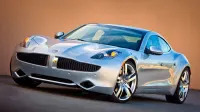Fisker Karma has “absolutely no mechanical connection” between engine and wheels

Fisker Automotive’s recent press release – the one that announced the delivery of the first production Karma – says that the car is:
… the world’s first extended-range electric vehicle – offering responsible luxury, incomparable performance and seating for four. Powered by twin 201-horsepower electric motors that may be augmented by an on-board engine generator, the Karma is capable of delivering over 300 miles of responsible driving – and a top speed of 125 miles per hour.
Confused by the usage of the word “augmented,” we asked: What does that mean, exactly? For a minute there, we were perplexed. Was Fisker really trying to pull a fast one on us?
Fortunately, there are guys like Russell Datz, director of internal communications at Fisker Automotive, who are armed with loads of vehicle-specific knowledge to make sense of ill-chosen words like “augmented.” Datz told AutoblogGreen that:
To clarify, the Karma has absolutely no mechanical connection between gas engine/generator and the traction wheels. When in driver-selectable Sport mode, the Karma’s engine/generator simply provides maximum electric power to drive the Karma to its top limited speed of 125 miles per hour and 0-60 time of 5.9 seconds.In the default all-electric Stealth mode, the Karma’s performance is tuned for efficiency and range. 0-60 is 6.9 seconds and top speed is limited to 95 mph.
So, there it is. The Fisker Karma – unlike the Chevrolet Volt – can’t ever call on its internal combustion engine to power the wheels. Which also explains, we think, why Fisker says the Karma is the, “world’s first extended-range electric vehicle.”
[Source: Fisker]




